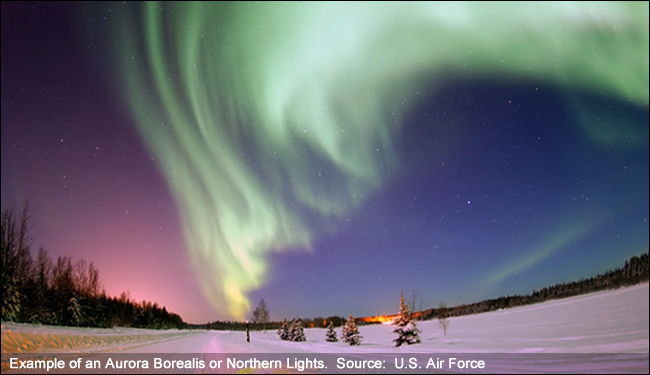
Strong space weather events are caused by interaction of the Earth with emissions from the Sun. The Sun continually streams out a solar wind consisting of charged particles, or plasma, travelling at high speeds throughout interplanetary space. The solar wind carries the solar magnetic field into space where it can interact with the magnetic field of planets like the Earth. Sometimes the solar wind gets particularly fast or turbulent and its magnetic field can trigger changes in the Earth's magnetic field and ionosphere–the region of the upper atmosphere that can conduct electricity. Such changes were termed Geomagnetic Storms as far back as the 19th century because they caused strong episodic gusts of compass needles that were unexplained until the 20th century when the solar wind was finally discovered.
The largest space weather events are caused when the Sun experiences a giant magnetic eruption from a sunspot region. These eruptions are announced by an immediate burst of electromagnetic radiation, including X-rays and ultraviolet light, called a solar flare. The impact of solar flare X-rays on the Earth's ionosphere causes a prompt loss of its ability to reflect long-range radio waves, resulting in a so-called Radio Blackout event. Following the X-ray flare, solar magnetic eruptions sometimes accelerate huge quantities of charged particle radiation into interplanetary space. If these particles impact the Earth's atmosphere they trigger solar radiation storms that can sometimes penetrate down to the ground. Most large eruptions also produce a coronal mass ejection (CME), a gigantic cloud of plasma and concentrated solar magnetic field hurling through space at millions of miles an hour. When a CME impacts the Earth's magnetic field, it can trigger the largest magnitude geomagnetic storms. For more details on each of these aspects of solar-driven space weather, see the links below. To see how space weather forecasters quantify each of these aspects, see the Space Weather Scales link in the side panel to the right.
 NASA's SOHO coronagraph displays a blizzard of high-energy particles saturating the camera's sensor, threatening the health and safety of some instruments. Source: NASA |
Solar radiation storms occur when large quantities of charged particles, protons and electrons, are accelerated by processes at or near the Sun. When these processes occur, the near-Earth satellite environment is bathed with high energy particles.
Earth's magnetic field and atmosphere offer some protection from this radiation, but the amount of protection is a function of altitude, latitude, and magnetic field strength. The polar regions are most affected by energetic particles because the magnetic field lines at the poles extend vertically downwards, allowing the particles to spiral down the field lines and penetrate into the atmosphere, increasing ionization.
Energetic protons reach Earth a half hour to several hours after a solar eruption. Solar radiation storms can last from a few hours to days, depending on the magnitude of the eruption. Solar radiation storms can occur at any time during the solar cycle but tend to be most common around solar maximum.
Solar radiation storm impacts include loss of HF radio communications through the polar regions, navigation position errors, elevated radiation exposure to astronauts, and to passengers and crew in aircraft at high altitudes and latitudes, and damage to satellite systems.
Geomagnetic storms, strong disturbances to Earth's magnetic field, pose problems for many activities, technological systems, and critical infrastructure. The Earth's magnetic field changes in the course of a storm as the near-Earth system attempts to adjust to the jolt of energy from the Sun carried in the solar wind. Coronal Mass Ejections (CMEs). Their effects can disturb the geomagnetic field for days at a time.
The most visible attribute of a geomagnetic storm is the aurora (see graphic top of page), which becomes brighter and moves closer to the equator. This heightened aurora signals the vigorous electrodynamic processes at play as they respond to the burst of energy. Geomagnetic storms usually last a few hours to days. The strongest storms may persist for up to a week.
A string of CMEs may cause prolonged disturbed periods related to the additional energy being pumped into Earth's magnetic field. The frequency of geomagnetic storms, in general, depends on where the Sun is in the solar cycle–with most storms occurring near solar maximum; however, these storms are also common in the declining phase due to highspeed solar wind streams. Geomagnetic storms induce currents that can have significant impact on electrical transmission equipment. Electricl power companies have procedures in place to mitigate the impact of geomagnetic storms.